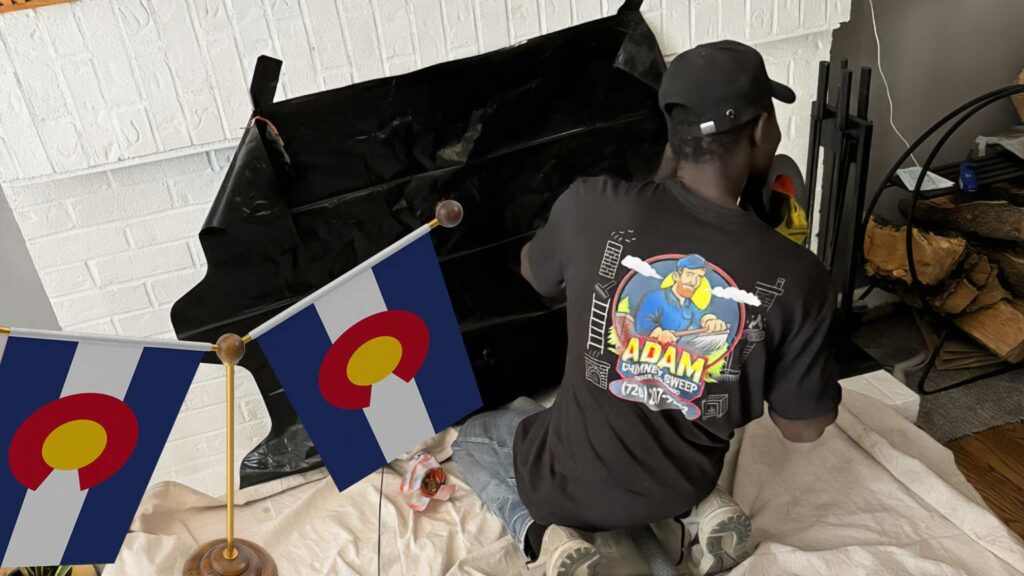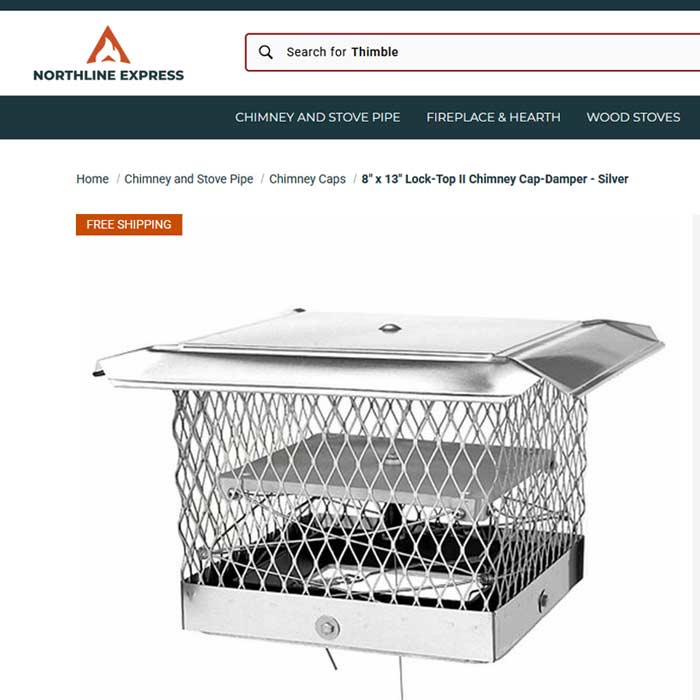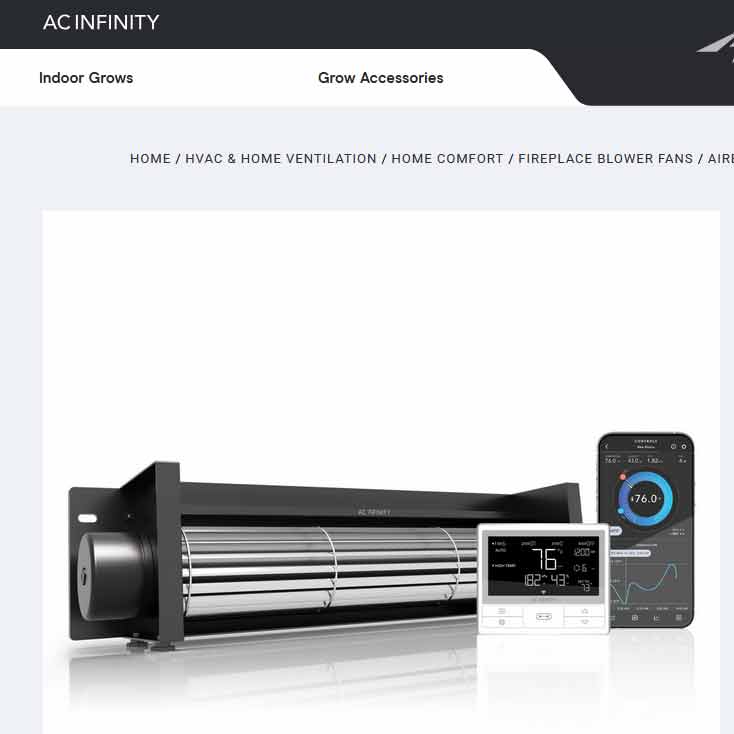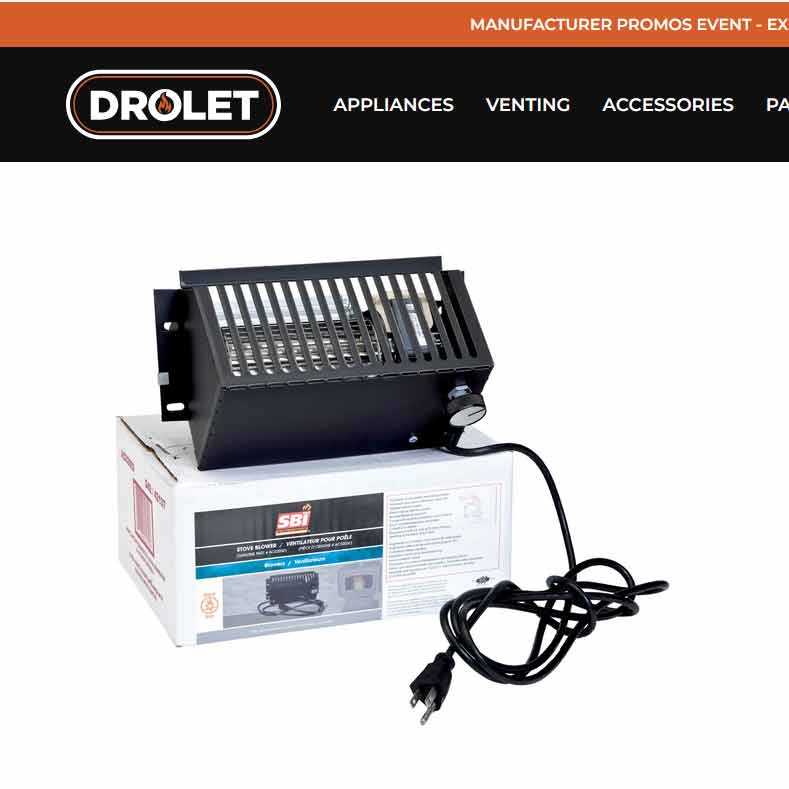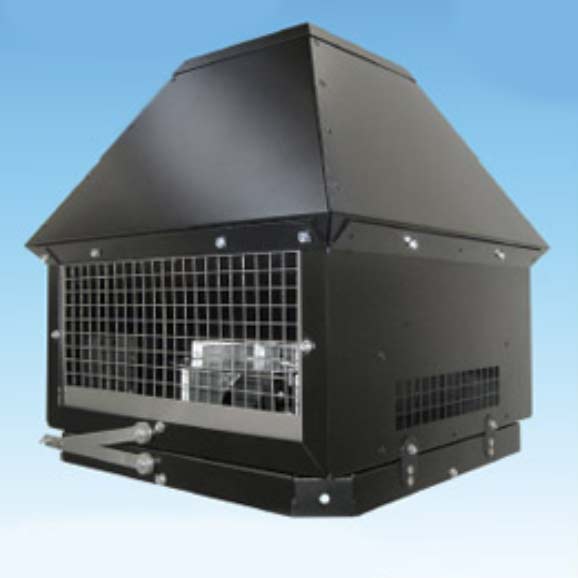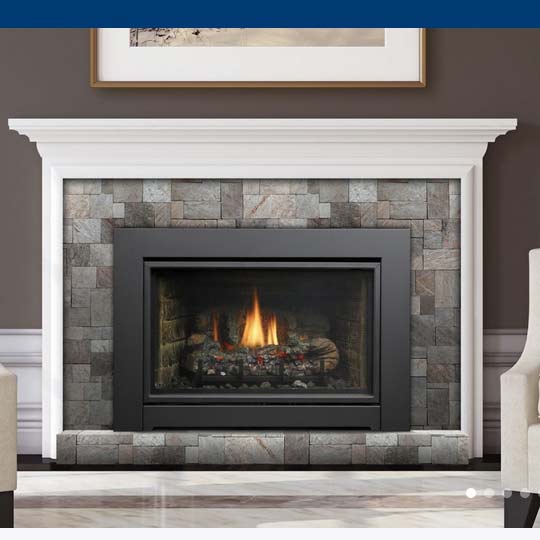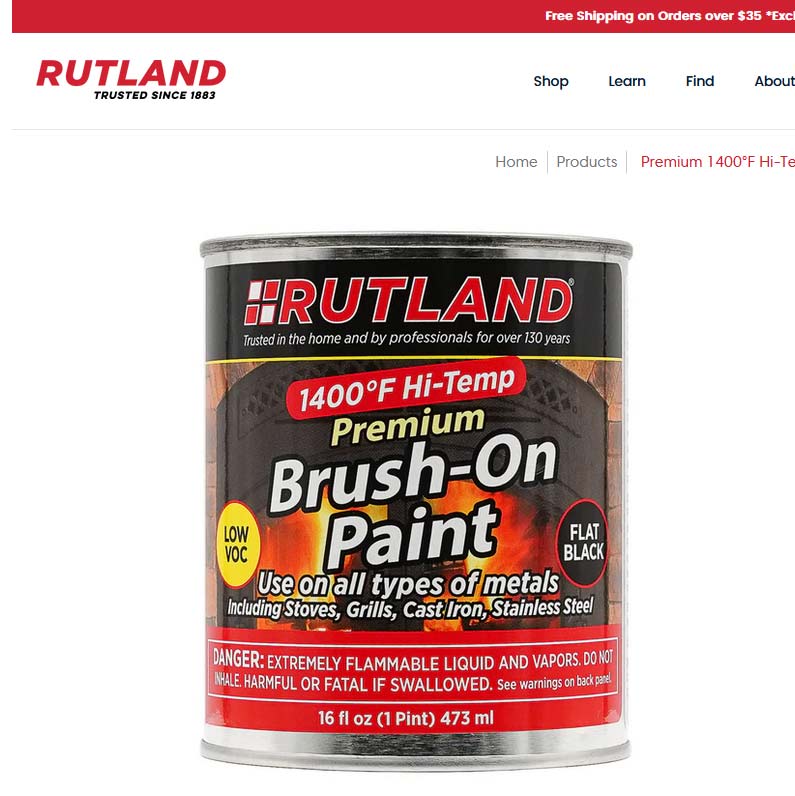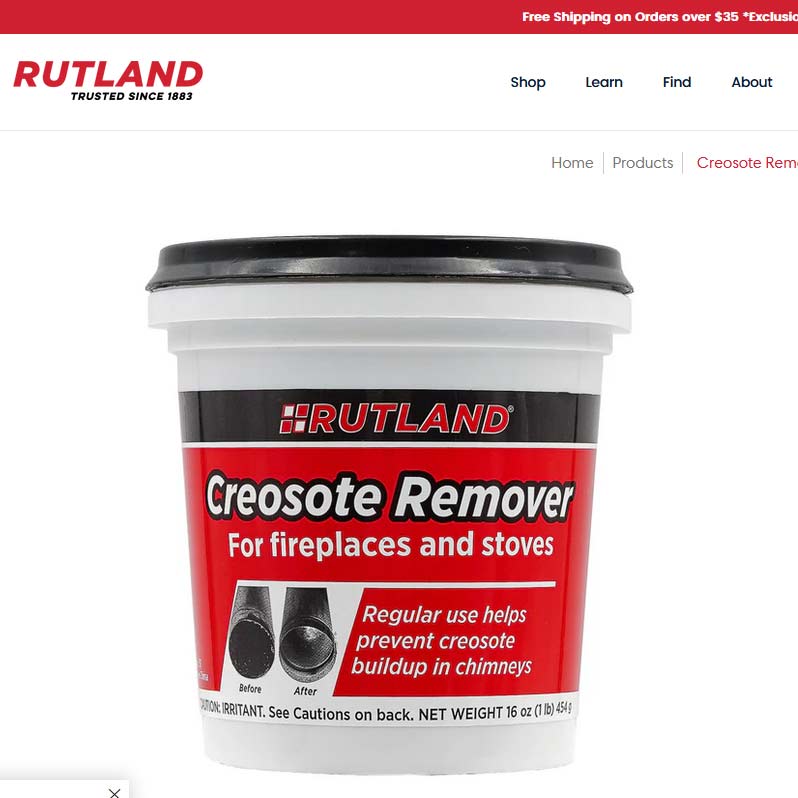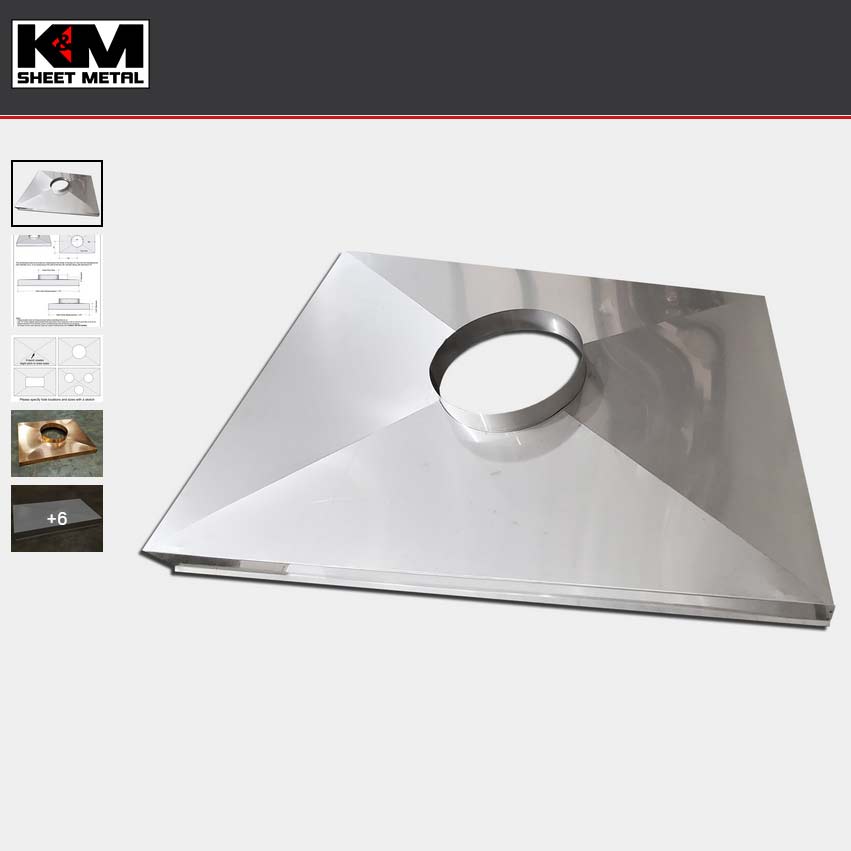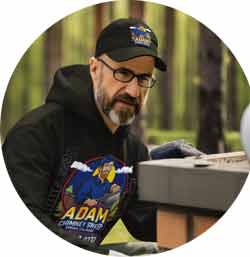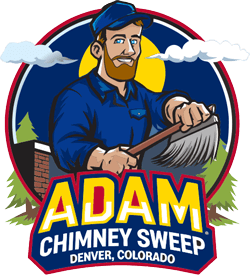Embracing the New Era of Chimney Design in the Mile High City
As the owner of Adam Chimney, I’ve witnessed firsthand how Denver homeowners are discovering the incredible potential hidden within their chimney systems. Over my fifteen years serving communities from Highlands Ranch to Westminster, I’ve seen a remarkable shift – chimneys are no longer just functional necessities but have become stunning architectural centerpieces that define modern Colorado living.
The transformation happening across our beautiful state is nothing short of revolutionary. From the historic brick homes in Wash Park to the contemporary builds in Green Valley Ranch, homeowners are embracing chimney remodeling to blend Colorado’s outdoor spirit with sophisticated interior design. This isn’t just about aesthetics – it’s about creating spaces that capture the essence of mountain living while incorporating cutting-edge technology and unmatched safety standards.
What makes this trend particularly exciting for us here in Colorado is how these modern designs work harmoniously with our unique climate and lifestyle. Whether you’re hosting friends after a day of skiing at Winter Park or creating a cozy reading nook during those long winter evenings, today’s chimney remodeling options offer solutions that are both beautiful and brilliantly functional.
The Colorado Advantage: Why Our State Leads Chimney Innovation
Living at 5,280 feet presents unique opportunities and challenges that have pushed chimney design to new heights. The reduced air density at our altitude affects combustion efficiency, while our dramatic temperature swings – from blazing summer afternoons to below-zero winter nights – demand materials and construction techniques that can withstand extreme conditions.
I’ve discovered that Colorado homeowners are particularly forward-thinking regarding home improvements. Perhaps it’s our adventurous spirit or deep appreciation for nature and innovation, but Coloradans consistently seek environmentally responsible, technologically advanced, and aesthetically striking solutions.
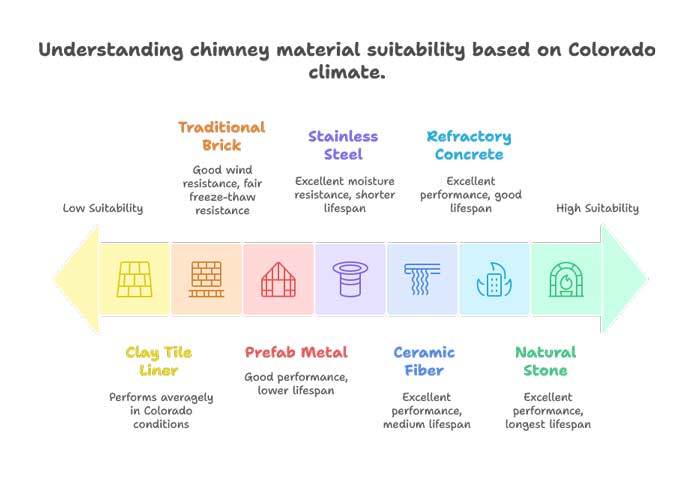
The flu systems I install today are light-years ahead of traditional designs. Modern chimney crown construction utilizes advanced concrete mixes and sealants formulated explicitly for our freeze-thaw cycles. Flashing techniques have evolved to handle our intense UV exposure and sudden weather changes, while damper systems now incorporate innovative technology that responds to indoor and outdoor conditions.
Table 1: Colorado Climate Impact on Chimney Materials – Performance Comparison
| Material Type | Freeze-Thaw Resistance | UV Resistance | Wind Load Capacity | Moisture Resistance | Altitude Performance | Colorado Suitability Score | Average Lifespan (Years) | Maintenance Frequency |
|---|---|---|---|---|---|---|---|---|
| Traditional Brick | Fair (3/5) | Good (4/5) | Excellent (5/5) | Fair (3/5) | Good (4/5) | 76% | 50-75 | Annual |
| Natural Stone | Excellent (5/5) | Excellent (5/5) | Excellent (5/5) | Good (4/5) | Excellent (5/5) | 96% | 75-100+ | Bi-annual |
| Stainless Steel | Excellent (5/5) | Good (4/5) | Good (4/5) | Excellent (5/5) | Excellent (5/5) | 92% | 25-50 | Every 3 years |
| Prefab Metal | Good (4/5) | Fair (3/5) | Good (4/5) | Good (4/5) | Good (4/5) | 80% | 15-25 | Annual |
| Refractory Concrete | Excellent (5/5) | Good (4/5) | Excellent (5/5) | Excellent (5/5) | Excellent (5/5) | 94% | 30-50 | Every 2 years |
| Clay Tile Liner | Fair (3/5) | Excellent (5/5) | Good (4/5) | Good (4/5) | Fair (3/5) | 74% | 50-75 | Annual |
| Ceramic Fiber | Excellent (5/5) | Excellent (5/5) | Good (4/5) | Excellent (5/5) | Excellent (5/5) | 94% | 20-30 | Every 5 years |
Scores based on performance in Colorado’s specific climate conditions, including altitude, temperature swings, UV exposure, and precipitation patterns.
Trending Now: Five Revolutionary Remodeling Approaches Taking Colorado by Storm
1. The Mountain Modern Aesthetic
This trend perfectly captures Colorado’s dual nature—rugged outdoor beauty meets refined interior comfort. I’m seeing incredible demand for chimneys that feature locally sourced stone exteriors paired with sleek metal interior components. Our aggregate often includes Colorado sandstone or granite, creating textures that echo our natural landscape.
These designs typically incorporate cantilever elements that create a dramatic visual impact while maintaining structural integrity. The soffit areas are designed with integrated lighting systems highlighting the stonework during evening hours, creating stunning focal points that work beautifully in Stapleton lofts and Evergreen mountain retreats.
2. Smart Integration Revolution
Technology integration is where I see the most excitement from my clients. Modern vent systems now connect to home automation platforms, allowing homeowners to monitor air quality, adjust draft settings, and even schedule maintenance reminders from their smartphones.
The combustion efficiency gains from these innovative systems are remarkable. I recently installed a system in Cherry Creek that reduced heating costs by 35% while improving indoor air quality. The homeowner can track real-time performance data and receive alerts if any issues develop, providing peace of mind that was unimaginable just a few years ago.
Table 2: Comprehensive Chimney Remodeling Cost Breakdown by Project Scope
| Project Category | Basic Package | Premium Package | Luxury Package | Materials Cost | Labor Cost | Permit Costs | Timeline | Warranty Period | ROI % |
|---|---|---|---|---|---|---|---|---|---|
| Fireplace Insert Installation | $2,500-$4,000 | $4,500-$7,000 | $8,000-$12,000 | 60% | 30% | 10% | 2-3 days | 5-10 years | 65-80% |
| Complete Chimney Rebuild | $8,000-$12,000 | $12,000-$18,000 | $20,000-$30,000 | 55% | 35% | 10% | 1-2 weeks | 15-25 years | 75-90% |
| Liner Replacement | $1,500-$3,000 | $3,500-$5,500 | $6,000-$8,500 | 65% | 25% | 10% | 1-2 days | 15-20 years | 70-85% |
| Crown & Cap Repair | $500-$1,200 | $1,200-$2,500 | $2,500-$4,000 | 50% | 40% | 10% | 1 day | 10-15 years | 80-95% |
| Smart System Integration | $1,800-$3,500 | $4,000-$6,500 | $7,000-$10,000 | 70% | 20% | 10% | 2-4 days | 5-10 years | 60-75% |
| Multi-Fuel Conversion | $3,000-$5,500 | $6,000-$9,000 | $10,000-$15,000 | 60% | 30% | 10% | 3-5 days | 10-15 years | 70-85% |
| Outdoor Connection | $4,000-$7,000 | $8,000-$12,000 | $15,000-$22,000 | 55% | 35% | 10% | 1-2 weeks | 10-20 years | 65-80% |
| Full Aesthetic Remodel | $5,000-$8,000 | $9,000-$15,000 | $18,000-$25,000 | 65% | 25% | 10% | 1-2 weeks | 15-25 years | 75-90% |
All prices include materials, labor, permits, and cleanup. The timeline assumes normal weather conditions and material availability. Prices are from Denver’s leading remodeling and construction calculators.
3. Multi-Fuel Flexibility
Colorado’s energy-conscious homeowners love having options. Modern remodeling projects often incorporate systems that can seamlessly switch between natural gas, propane, and even wood pellets. The burner assemblies I install today can adapt to fuel availability and cost fluctuations while maintaining consistent performance.
This flexibility proved invaluable during recent supply chain disruptions. Homeowners with multi-fuel systems could adjust their heating strategy based on availability and pricing, demonstrating the practical wisdom of forward-thinking design.
4. Indoor-Outdoor Connectivity
Perhaps no trend better captures Colorado living than designs that blur the line between interior and exterior spaces. Fireboxes that serve indoor living areas and outdoor patios are becoming increasingly popular, especially in neighborhoods like Highlands Ranch and Castle Pines, where outdoor entertaining is a year-round activity.
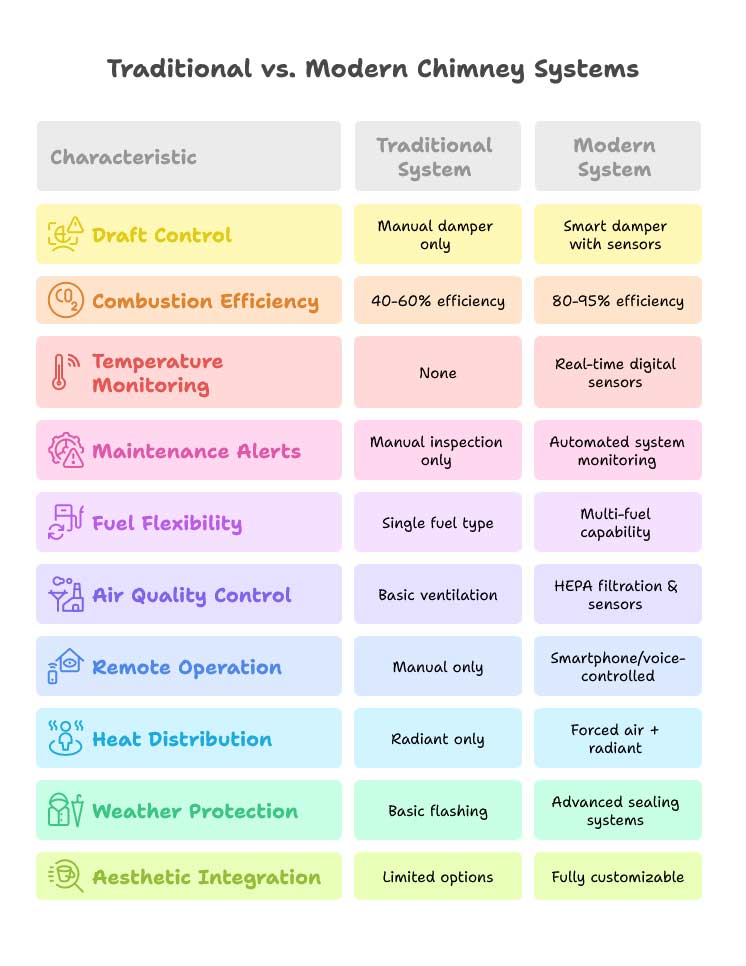
These systems require sophisticated ventilation engineering to handle varying wind conditions and ensure proper airflow in all weather. The heat exchanger technology allows for efficient operation, whether warming the living room during a snowstorm or creating ambiance for a summer evening gathering.
Table 3: Traditional vs. Modern Chimney Systems Feature Comparison
| Feature Category | Traditional System | Modern System | Improvement Factor | Colorado Climate Benefit | Safety Enhancement | Energy Efficiency Gain |
|---|---|---|---|---|---|---|
| Draft Control | Manual damper only | Smart damper with sensors | 300% | Adapts to altitude & wind | Prevents backdraft | 25-40% heat retention |
| Combustion Efficiency | 40-60% efficiency | 80-95% efficiency | 150% | Better high-altitude performance | Complete fuel burn | 35-50% cost savings |
| Temperature Monitoring | None | Real-time digital sensors | N/A | Freeze protection alerts | Overheating prevention | Optimal fuel usage |
| Maintenance Alerts | Manual inspection only | Automated system monitoring | N/A | Weather damage detection | Early problem identification | Prevents efficiency loss |
| Fuel Flexibility | Single fuel type | Multi-fuel capability | 200-300% | Adapts to supply/cost changes | Backup fuel options | Cost optimization |
| Air Quality Control | Basic ventilation | HEPA filtration & sensors | 400% | Handles altitude air density | Removes harmful particles | Reduces heating Load |
| Remote Operation | Manual only | Smartphone/voice-controlled | N/A | Pre-heating before arrival | Safety shutoffs | Scheduled operation |
| Heat Distribution | Radiant only | Forced air + radiant | 150% | Even heating in large spaces | Eliminates cold spots | 20-30% better efficiency |
| Weather Protection | Basic flashing | Advanced sealing systems | 250% | Extreme weather resistance | Prevents water damage | Maintains insulation |
| Aesthetic Integration | Limited options | Fully customizable | 500% | Matches Colorado style preferences | Hidden safety features | Optimized placement |
Improvement factors represent a percentage increase in performance or capability compared to traditional systems.
5. Sustainable Material Innovation
Environmental consciousness drives many Colorado homeowners’ decisions. I’m installing more refractory materials from recycled content, and insulation systems that dramatically reduce heat loss. Thermal barrier innovations help maintain consistent temperatures while minimizing energy consumption.
Our masonry work now often incorporates reclaimed materials, which is particularly attractive when working with historic homes in neighborhoods like Capitol Hill or Park Hill. These sustainable approaches align with Colorado’s environmental values while creating unique, character-rich installations.
A Success Story from Littleton: Transforming a 1980s Ranch into a Modern Masterpiece
Last spring, I worked with the Johnson family in Littleton’s Columbine neighborhood. Their 1980s ranch home had a traditional brick fireplace that dominated their living room but lacked warmth or visual appeal. The existing chimney cap was deteriorating, and the mortar joints showed significant weathering from Colorado’s harsh climate.
“We loved entertaining, but our fireplace was more decorative than functional,” Sarah Johnson told me. “We wanted something to heat our great room and work with our updated décor.”
The transformation took three weeks and completely reimagined their living space. We replaced the outdated firebox with a high-efficiency gas insert featuring ceramic glass panels and radiant heating elements. The original brick was refaced with locally-sourced flagstone, and we installed a custom mantel crafted from reclaimed barn wood.
The technical improvements were equally impressive. A new stainless steel liner improved combustion efficiency by 40%, while smart controls allow the Johnsons to adjust heat output and flame appearance from anywhere in the house. Sealing the system eliminated drafts, cooling their home during the winter months.
“The difference is incredible,” Sarah shared six months later. “Our heating bills dropped significantly, and the new fireplace has become the heart of our home. We use it almost daily during winter; even our summer gatherings center around the beautiful stonework.”
The project cost $8,500, including all materials and labor, but the Johnsons’ home appraisal increased by $15,000. More importantly, they gained a feature that perfectly suits their lifestyle and Colorado’s climate demands.
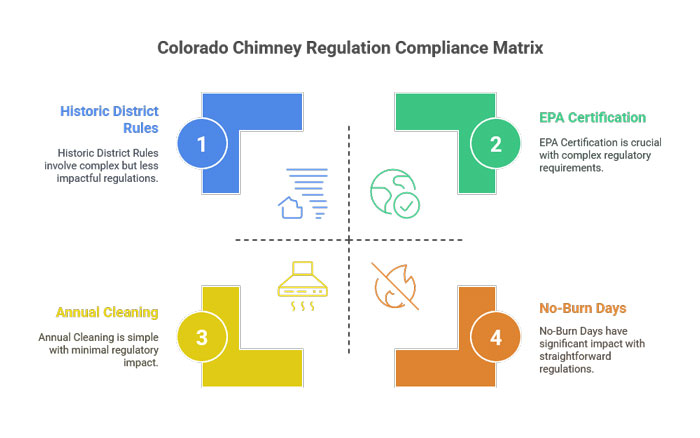
Navigating Colorado’s Unique Climate Challenges
Our state’s weather patterns create specific demands that influence every remodeling decision I make. Expansion and contraction from temperature swings stress traditional materials, while our intense UV exposure can degrade sealants and coatings more rapidly than in other regions.
Table 4: Colorado Chimney Regulations & Compliance Requirements
| Regulation Category | Denver Metro | Mountain Counties | Plains Region | Compliance Timeline | Penalty Range | Inspection Required |
|---|---|---|---|---|---|---|
| Height Requirements | 2 ft above the roof within 10 ft | 3 ft above the roof within 10 ft | 2 ft above the roof within 10 ft | Before installation | $200-$500 | Yes |
| Annual Cleaning | Mandatory for wood-burning | Mandatory for all types | Recommended | By December 31 | $100-$300 | Level 1 required |
| No-Burn Days | Strictly enforced | Altitude exemptions apply | Strictly enforced | November-March | $100-$15,000/day | N/A |
| EPA Certification | Required for new installs | Required for new installs | Required for new installs | At the time of purchase | Equipment confiscation | Pre-installation |
| Permit Requirements | All major work | All structural work | Major work only | Before work begins | Work stoppage | Multiple phases |
| Emissions Testing | Required for violations | Annual for commercial | Required for violations | Within 30 days | $500-$2,000 | Certified technician |
| Insurance Compliance | Policy-dependent | Policy-dependent | Policy-dependent | Annual certification | Coverage denial | Annual |
| Historic District Rules | Additional restrictions | Varies by location | Minimal restrictions | 60-day review process | Project denial | Historical society |
| HOA Requirements | Architectural approval | Varies significantly | Minimal oversight | 30-45 days | Modification orders | Varies |
| Professional Licensing | Required for all work | Required for all work | Required for all work | Valid at work start | $1,000-$5,000 | State verification |
Penalties can be cumulative and may include additional fees for non-compliance correction.
Moisture management is critical. Snow loading on roof surfaces can force water into flashing systems, while our dry air can cause cracking in masonry components. I always recommend waterproofing treatments formulated explicitly for high-altitude conditions.
Wind patterns in Colorado require special attention to draft characteristics. Homes in exposed locations like Golden’s foothills or the plains around Parker need chimney heights calculated for local wind conditions. Downdrafts can be particularly problematic during Chinook wind events.
My clearances around chimney installations account for our heavy snow loads and ice formation. Structural components must handle not just the chimney’s weight but also significant snow accumulation and ice dams that can form during spring melts.
Investment Considerations: What Your Remodeling Dollar Buys
Understanding costs helps homeowners make informed decisions. Our chimney sweep services start at $150, providing the foundation for any remodeling assessment. Inspection services reveal existing conditions and help prioritize improvements.
Basic remodeling projects, including refacing, liner upgrades, and damper improvements, typically cost $3,000 to $8,000. Mid-range projects ($8,000 to $15,000) often include complete combustion system upgrades, innovative technology integration, and significant aesthetic improvements.
Table 5: Energy Efficiency & Performance Comparison by System Type
| System Type | BTU Output Range | Efficiency Rating | Annual Fuel Cost | Heat Coverage (Sq Ft) | Colorado Climate Rating | Environmental Impact | Smart Features | Maintenance Hours/Year |
|---|---|---|---|---|---|---|---|---|
| Traditional Wood | 15,000-40,000 | 40-60% | $800-$1,200 | 800-1,500 | Fair | High emissions | None | 15-25 |
| EPA Wood Stove | 20,000-60,000 | 70-85% | $600-$900 | 1,000-2,000 | Good | Low emissions | Basic | 8-12 |
| Gas Insert | 10,000-40,000 | 80-95% | $400-$700 | 800-1,800 | Excellent | Very low emissions | Full integration | 2-4 |
| Pellet Stove | 8,000-50,000 | 85-95% | $500-$800 | 1,000-2,200 | Good | Low emissions | Moderate | 6-10 |
| Electric Insert | 5,000-25,000 | 99% | $600-$1,100* | 600-1,200 | Fair | Zero direct emissions | Full integration | 1-2 |
| Dual-Fuel System | 15,000-55,000 | 75-90% | $450-$850 | 1,200-2,500 | Excellent | Variable | Advanced | 4-8 |
| Heat Pump Hybrid | 12,000-45,000 | 150-300%** | $300-$600 | 1,000-2,000 | Excellent | Very low emissions | Full smart home | 2-5 |
| Geothermal Assist | 20,000-60,000 | 200-400%** | $250-$500 | 1,500-3,000 | Excellent | Minimal emissions | Advanced | 3-6 |
*Electric costs vary significantly with utility rates and time-of-use pricing. **Heat pump efficiency ratings exceed 100% due to heat transfer rather than generation. **Coverage areas assume standard insulation and Colorado climate conditions
Comprehensive remodeling can reach $15,000 to $25,000, especially for projects involving structural modifications, multi-fuel capability, or outdoor connectivity features. However, these investments typically return 75-90% of their cost in increased home value while providing immediate improvements in comfort and efficiency.
Modern systems significantly decrease maintenance costs. Traditional chimneys might require annual repointing or sealing, while contemporary installations often need only routine cleaning and occasional gasket replacement.
Brilliant Material Selection for Colorado Conditions
Material choice determines long-term success in our challenging climate. Stainless steel components resist corrosion from condensation and chemical exposure while handling temperature extremes without degradation. Refractory panels withstand rapid heating and cooling cycles that would crack traditional materials.
Insulation technology has advanced remarkably. Modern thermal barriers maintain consistent temperatures while preventing heat loss through chimney walls. Vapor barriers control moisture movement that can cause spalling in masonry components.
Table 6: Maintenance Schedule & Requirements by System Type
| System Component | Traditional Schedule | Modern Schedule | Colorado Considerations | DIY Capability | Professional Cost | Warning Signs | Seasonal Timing |
|---|---|---|---|---|---|---|---|
| Chimney Cleaning | Monthly (wood burning) | Bi-annually | High-altitude creosote buildup | No | $150-$300 | Smoke spillage, odors | Spring & Fall |
| Crown Inspection | Annually | Every 2 years | Freeze-thaw damage critical | Visual only | $75-$150 | Cracks, water stains | Spring |
| Flashing Check | Annually | Every 2 years | UV/weather degradation | Visual only | $100-$200 | Roof stains, leaks | After storms |
| Damper Operation | Seasonally | Automated alerts | Ice formation issues | Yes | $150-$400 | Sticking, rust | Fall preparation |
| Liner Inspection | Every 2 years | Every 3-5 years | Altitude stress factors | No | $200-$400 | Draft issues, corrosion | Annual |
| Cap/Screen Check | Seasonally | Automated monitoring | Animal/debris problems | Yes | $100-$250 | Blockages, damage | Monthly visual |
| Smart System Updates | N/A | Automatic/as needed | Software compatibility | User-friendly | $0-$200 | Error messages, connectivity | Continuous |
| Gasket Replacement | Every 3-5 years | Every 5-8 years | Dry air effects | Moderate skill | $50-$150 | Air leaks, efficiency loss | As needed |
| Refractory Repair | Every 5-10 years | Every 10-15 years | Thermal cycling stress | No | $300-$800 | Cracking, deterioration | Before heating season |
| Waterproofing | Every 2-3 years | Every 5-7 years | Intense weather exposure | Moderate skill | $200-$500 | Water penetration | Late spring |
Professional costs include diagnostic time and basic repairs—major work quoted separately.
Sealant selection requires understanding Colorado’s UV intensity and temperature ranges. Products that work well in moderate climates often fail quickly at our altitude. I use elastomeric compounds specifically rated for high-altitude applications.
Aggregate choices affect both appearance and durability. Local stone varieties look natural and perform well in Colorado because they adapt to our climate conditions. Mortar formulations must accommodate thermal movement without compromising structural integrity.
Regulatory Excellence: Staying Compliant in Colorado
Colorado’s building codes reflect our unique fire risks and environmental conditions. Fire safety requirements are particularly stringent given our wildfire exposure and dry climate conditions. Clearance specifications ensure safe operation while ventilation standards maintain indoor air quality.
Emissions standards in the Denver metro area require EPA-certified appliances during certain atmospheric conditions. These “no-burn” days protect air quality, making high-efficiency systems more valuable because they can operate cleanly when older systems cannot.
Permits ensure work meets current safety standards. The inspection process verifies proper installation and helps homeowners avoid costly corrections later. Code compliance also protects insurance coverage and home value.
Professional installation provides warranties and ensures adherence to manufacturer specifications. Certified technicians understand local codes and can navigate permitting processes efficiently, saving homeowners time and potential complications.
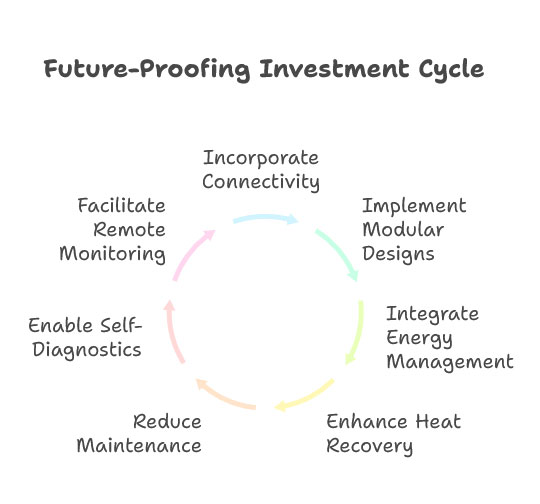
Future-Proofing Your Investment
Technology continues evolving rapidly. Systems I install today incorporate connectivity options that allow future upgrades without major reconstruction. Modular designs accommodate new sensors, controls, and efficiency improvements as they become available.
Energy management integration positions homes for evolving utility programs and renewable energy systems. Heat recovery capabilities work synergistically with solar installations and battery storage systems.
Maintenance requirements continue decreasing as materials and designs improve. Self-diagnostic capabilities identify issues before they become problems, while remote monitoring allows professional service teams to track performance and schedule maintenance proactively.
The Adam Chimney Commitment to Excellence
After serving Colorado homeowners for over a decade, I understand that successful remodeling requires more than technical expertise – it demands understanding how families live and what makes a house feel like home. Every project I undertake reflects my commitment to safety, efficiency, and the unique character that makes Colorado living special.
My certified team brings extensive training in the latest installation techniques, safety protocols, and technology integration. We maintain current certifications and regularly attend training programs to stay current with evolving standards and innovations.
Quality materials from trusted suppliers ensure lasting performance in Colorado’s demanding climate. Warranty coverage provides peace of mind, while our local presence means responsive service when needed.
Transparent pricing eliminates surprises. Detailed proposals outline every aspect of your project, from materials and labor to permits and cleanup. There are no hidden fees or unexpected charges—honest, professional service.
Your Next Step Toward Chimney Excellence
The perfect time to explore chimney remodeling is before another Colorado winter tests your existing system. Whether you’re drawn to mountain modern aesthetics, innovative technology integration, or want improved efficiency and safety, modern remodeling options offer solutions that enhance your home’s value and your family’s comfort.
I invite you to discover what’s possible for your home. Our comprehensive assessment identifies opportunities and provides realistic expectations for your investment. From simple upgrades to complete transformations, we’ll help you create a chimney system that perfectly suits your lifestyle and Colorado’s unique demands.
Contact Adam Chimney at (720) 207-9232 to schedule your complimentary consultation. You can also visit our Aurora location at 12894 E Villanova Dr, Aurora, CO 80014. Let’s transform your chimney into the stunning, efficient centerpiece your Colorado home deserves.
Experience the Adam Chimney difference – where Colorado expertise, cutting-edge technology, and unwavering commitment to excellence come together to create chimney systems that define modern mountain living.
Colorado Chimney Remodeling Regulations: Essential Guide
Statewide Requirements
EPA Standards
Colorado aligns with federal EPA standards for wood-burning appliances:
- Phase III (2020+): New installations must emit ≤2.0 g/hr particulates
- Phase II (1995+): Older certified stoves remain legal and exempt from Action Day restrictions
- Non-EPA stoves: Cannot be sold/installed; existing ones may continue to be used except in Action Day counties
Air Quality Action Days
Seven Denver metro counties (Denver, Boulder, Broomfield, Douglas, Jefferson, Adams, Arapahoe west of Kiowa Creek) have burning restrictions from October 31 to March 31:
- Prohibited: Uncertified stoves and conventional fireplaces
- Exempt: EPA-certified stoves, homes above 7,000 ft elevation, sole heat source usage, pellet stoves
Appliance Definitions
- Wood-burning stove: Metal appliance with <35:1 air-to-fuel ratio, <20 cubic ft firebox, <5 kg/hr burn rate
- Pellet stove: Must emit <4.1 g/hr, pellet-fuel only
- Masonry heater: ≥800 kg masonry construction with horizontal/downward heat ducts
- Wood-burning fireplace: Open hearth, primarily masonry construction
County-Specific Regulations
Denver County
- Codes: 2021 ICC (adopting 2024 ICC, spring 2025), 2023 NEC
- Requirements: Chimneys 2+ ft above surrounding structures, EPA Phase III for wood-burning
- Permits: Mandatory for all construction/alterations via the e-permits portal
- Maintenance: Annual NFPA inspections (Level 1, 2, 3)
El Paso County (PPRBD)
- Codes: 2023 Regional Building Code (2021 IBC/IRC base), 2023 NEC
- Requirements: No appliance connections to fireplace flues, no single-wall metal vents
- Permits: Required for most improvements at PPRBD
- Maintenance: Annual inspections per NFPA 14.2, mandatory cleaning if creosote >1/4 inch
Arapahoe County
- Codes: County uses 2018 International Codes; municipalities vary (Centennial: 2021 codes)
- Requirements: EPA-approved wood-burning, factory-built, needs testing lab approval
- Permits: Online via the Accela portal
- Special: Centennial requires chimneys 3+ ft above roofline, cleaning if soot >1/8 inch
Jefferson County
- Codes: 2018 IBC/IRC, 2023 NEC, local fire districts have additional authority
- Requirements: New fireplaces must have gas logs, electric, or AQCC-compliant inserts; spark arresters are required
- Permits: Miscellaneous permit for factory-built, residential permit for masonry via Jefferson County Permits
- Note: Check local fire district requirements – Fire Districts Map
Larimer County
- Codes: 2021 International Codes, 2023 NEC
- Requirements:
- Restricted Areas: Gas, electric, or Phase III certified only (post-Jan 2002)
- All Areas: Wood stoves/inserts post-May 2020 must meet 2.0-2.5 g/hr emissions
- Permits: Online via customer portal
- Fort Collins: EPA-certified only, ≤20% smoke opacity after 15-minute startup
Boulder County
- Codes: 2024 ICC (effective Aug 2025), 2024 CoBECC, 2023 NEC
- Requirements: EPA Phase III for wood-burning, spark arresters, dry seasoned wood only
- Permits: Customer Self-Service Portal for applications
- Special: EZ BPs available for no-plan residential projects
Key Permit & Inspection Requirements
| County | Permit Portal | Key Requirements | Inspection Notes |
|---|---|---|---|
| Denver | CPD e-permits | All construction/alterations | Annual NFPA cleaning |
| El Paso | PPRBD Online | Most home improvements | Annual damage/buildup checks |
| Arapahoe | Accela Portal | Licensed contractors required | Level 1/2 inspections |
| Jefferson | County Permits | Check the fire district authority | Manufacturer instructions on-site |
| Larimer | Customer Portal | Phase III compliance | Annual service recommended |
| Boulder | Self-Service Portal | EZ BPs for simple projects | Level 1 inspections mandated |
Critical Compliance Steps
Before Starting
- Contact the local building department and fire district directly
- Verify current adopted codes – they update every 2-3 years
- Check HOA requirements if applicable
- Confirm EPA certification for any wood-burning appliance
During Project
- Obtain all required permits before work begins
- Use licensed contractors when required
- Keep the manufacturer’s instructions on-site for inspections
- Schedule required inspections promptly
After Completion
- Maintain permit/inspection records
- Schedule annual cleaning/inspections
- Use only dry, seasoned wood
- Monitor creosote buildup (clean if >1/8 to 1/4 inch depending on jurisdiction)
Consequences of Non-Compliance
- Fines and penalties from local authorities
- Stop-work orders halting construction
- Insurance claim denials for unpermitted work
- Property sale complications requiring corrective action
- Safety hazards from improper installation
Additional Resources
Fire District Contacts
- West Metro Fire: Forms & Permits
- South Metro Fire: Development & Construction
- Foothills Fire: Fire Prevention & Permits
Specialized Guides
- Denver Quick Permits: Quick Permits Guide
- PPRBD Code Changes: Code Updates
- Larimer County Fireplace Guide: Fireplace/Wood Stove PDF
Remember: Regulations vary significantly by jurisdiction and change frequently. Always verify current requirements with local authorities before beginning any chimney remodeling project.
